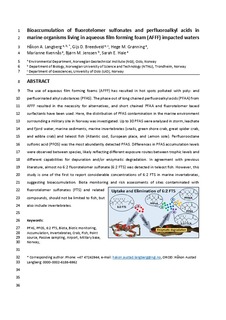Bioaccumulation of Fluorotelomer Sulfonates and Perfluoroalkyl Acids in Marine Organisms Living in Aqueous Film-Forming Foam Impacted Waters
Langberg, Håkon Austad; Breedveld, Gijs D.; Grønning, Hege Mentzoni; Kvennås, Marianne; Jenssen, Bjørn Munro; Hale, Sarah
Peer reviewed, Journal article
Accepted version
Permanent lenke
http://hdl.handle.net/11250/2644777Utgivelsesdato
2019Metadata
Vis full innførselSamlinger
- NGI articles [1037]
Originalversjon
Environmental Science and Technology. 2019, 53 (18), 10951-10960. 10.1021/acs.est.9b00927Sammendrag
The use of aqueous film-forming foams (AFFFs) has resulted in hot spots polluted with poly- and perfluorinated alkyl substances (PFASs). The phase out of long-chained perfluoroalkyl acids (PFAAs) from AFFFs resulted in the necessity for alternatives, and short-chained PFAAs and fluorotelomer-based surfactants have been used. Here, the distribution of PFAS contamination in the marine environment surrounding a military site in Norway was investigated. Up to 30 PFASs were analyzed in storm, leachate, and fjord water; marine sediments; marine invertebrates (snails, green shore crab, great spider crab, and edible crab); and teleost fish (Atlantic cod, European place, and Lemon sole). Perfluorooctanesulfonic acid (PFOS) was the most abundantly detected PFAS. Differences in PFAS accumulation levels were observed among species, likely reflecting different exposure routes among trophic levels and different capabilities for depuration and/or enzymatic degradation. In agreement with previous literature, almost no 6:2 fluorotelomer sulfonate (6:2 FTS) was detected in teleost fish. However, this study is one of the first to report considerable concentrations of 6:2 FTS in marine invertebrates, suggesting bioaccumulation. Biota monitoring and risk assessments of sites contaminated with fluorotelomer sulfonates (FTSs) and related compounds should not be limited to fish, but should also include invertebrates.
